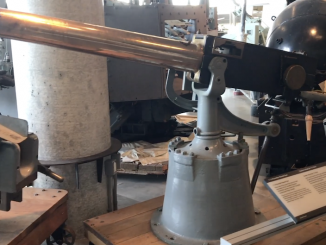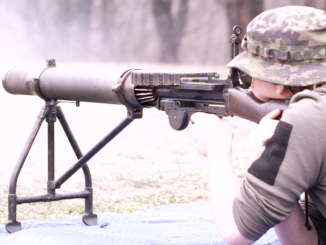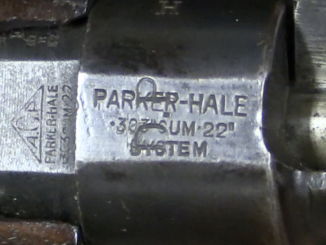https://youtu.be/hcmVCb_ZgZA
There are a fairly wide variety of silenced Sten guns that were made during World War Two, because many were needed for small Special Operations Executive missions. However, the British Army did also formally develop and adopt such a weapon. It was initially requested in 1942, with the first trials in November of that year. After two years of tinkering and deliberating, a pattern was finally put into production in February 1944. This was a Sten MkII with an integrally suppressed barrel. The barrel was just 3.75 inches long, with six vent holes drilled just in front of the chamber to reduce muzzle velocity below the speed of sound. The silencer itself was about 12 inches long, with an initial expansion chamber and 18 baffles.
Since the vented barrel reduced recoil energy of the cartridge, the bolt was reduced in weight by about 15% and the recoil spring shorted just slightly as well, to ensure proper cycling. The result was formally designated the Sten MkII(S). It retained the selective fire capability of the Sten, but was not to be used in automatic mode, as doing so could compress the baffles together and damage them. In total, 5,776 of these silent submachine guns were made. The design was followed by a more sophisticated Sten Mk6 (essentially a silenced Mk5), but remained in active use with the British military into the early 1970s.
Finding completely original and intact examples of the MkII(S) is extremely difficult today, and this one is a rare privilege to examine!




I guess it’s quite unlikely that Ian will take this to the range, let alone for a mag dump!
Please pull the plunger and rotate the magazine housing before unscrewing the barrel nut. This disengages the ratchet from the nut, eliminating wear. When reassembling, install the nut, rotate the magazine housing, and give the nut a final twist.
I suppose someone on the other team “conveniently disappeared” in the woods whenever an operative was sneaking around with this gun.
Man, 25,000 silenced submachine guns?! How many special operators, spies, agents, etc did the British think they had?! And (besides cost), why use the Sten as the base, when you’re not supposed to fire it on automatic? The DeLisle carbine wasn’t good enough?
A bolt-action silent carbine would be great for a one-shot assassination, but if you failed to kill your intended victim on the first shot, you would be hopelessly outmatched in rate-of-fire once the other team drew their weapons. A Sten, even on single-shot mode, outperforms a DeLisle in firing rate. Where are you going to get .45 ACP in occupied Europe, and just how do you hide the DeLisle when it isn’t being used?
“(…)why use the Sten as the base(…)”
If you order 25000 examples you need at least 25000 examples of base weapon
https://modernfirearms.net/en/military-rifles/bolt-action-rifles/great-britain-bolt-action-rifles/de-lisle-commando-eng/
(…)De Lisle silenced Commando carbines were produced(…)using rejected SMLE No.1 Mk.3 rifle stocks and actions and Thompson submachine gun barrels(…)
Do they have at least 25000 broken “SMLE No.1 Mk.3 rifle stocks” and at least 25000 excessive “Thompson submachine gun barrels” at hand?
Fantastic gun
Really interesting, please Don’t let what follows detract from the gun or Ian’s presentation.
Its interesting how inefficient the WWii silencers were in terms of volume for effect compared with the earlier Maxim silencers.
The Various STEns were some of the better ones
Wipes are an absolute abomination. An attempt to correct a bad design by making it even worse. Anything that touches a bullet after it leaves the muzzle (apart from the target) doesn’t help.
The spiral baffles in STEn, Sterling and Sionics silencers, are no more effective than ordinary punched baffles that look like washers, but they’re harder to make
Perhaps they impress bureacrats?
Bits of wire wool and pan scrubber? Cheap, nasty, absorb some heat, and get fouled.
Drilled barrels
Why not just cut the barrel shorter?
If you can’t dazzle them with diamonds, baffle them with
bullshitspirals and pan scrubbers.The calculation and knowledge problems ensure that central planning will almost always be sub optimal (it can never possibly be super optimal).
They cut the barrel to 3 1/2 inches. The hot loading of 9 para from a 3.5″ is still supersonic, so they drilled the barrel.
“The hot loading of 9 para from a 3.5″ is still supersonic”(C)
Not only.
The more gas you take before the bullet leaves the muzzle, the more effective expansion-type suppressors work.
It also reduces breakout noise from the back of the barrel and reduces the risk of brass breakage when using a lightweight bolt.
“(…)Why not just cut the barrel shorter?(…)”
One of tasks of barrel in 20th century machine carbine was imparting spin at bullet. For fixed twist pitch if you would cut too much, you would end with bullets which are not correctly stabilized.
Back in 2019 at Neuvic s/ Isle gunshow in the Dordogne France there was a neutrilized silenced sten that had apparently be parachuted near Perigueux at the end of the war. It did have the lightened bolt.
Unfortuntly the owner was not around so I couldnt get its history
Keith although wipes and packing are not durable enough on military weapons they can be alright for plinking
The quietest .22 silencer I ever used was 6 inches of thick walled 1/8 inch pipe. There was a 1/2 x 20 nut welded on one end and the other end had a female nut with a rubber washer galvanized into it with a 1/4 inch exit hole so the bullet did not touch it.The packing was steel wool saturated with gun oil.Out side of an australian GOLD SPOT it gave the best reduction and just needed a handfull of steel wool every 2 or 300 rounds
Cool beginning of the video. 😉
Bu, in reality, one fighter with STEN was getting 20-25 yards to the patrol, and the second, trying to get closer. 10-15 yards.
With a knife, as a safety net.
Tellingly, when using De Lisle, the second number was not needed.
The post referred to the shooting video.
Got out my copy of Laidler’s The Sten Machine Carbine. The silencer unit on this gun isn’t the pattern used on the Mk. IIS. It is much closer to the Mk. VI unit. Laidler points out that the Mk. IIS and Mk. VI units were interchangeable, and Mk. VI units were installed on Mk. II carbines as required. Doesn’t mean it is incorrect – just that the silencer was an upgraded version.
There were two main versions of the suppressor itself.
Developed and adopted by various services.
If I recall correctly, there were a number of suppressed STEN’s with bronze bolts as well
“…bronze bolts…”(С)
Bronze bolts were used on STENs Mk2 and 3 made for the Navy.
This was done mainly to reduce production labor costs.
https://www.ima-usa.com/products/british-sten-gun-bronze-bolt-assembly-original-wwii?variant=25651407877
And the byproduct was a slight reduction in the rate of fire and the prevention of corrosion.
The use of such a bolt in the suppressed version of STEN will make it a manually loaded weapon. So I don’t think so, although, technically, it’s possible.
Some years ago I got to shoot one of these. I was just wearing cheap open-cell foam earplugs but it was so quiet when I squeezed the trigger that I thought it must have misfired. But when I looked at the gun, the bolt was locked back. I knew I’d felt the bolt fall, and the Sten fires from the open bolt so the only reason it could have returned to the locked position is if it had fired. So the next shot I kept a keen eye out for the bullet’s impact and low and behold, the darn thing was shooting, but the bolt cycling was making more noise than the muzzle blast.